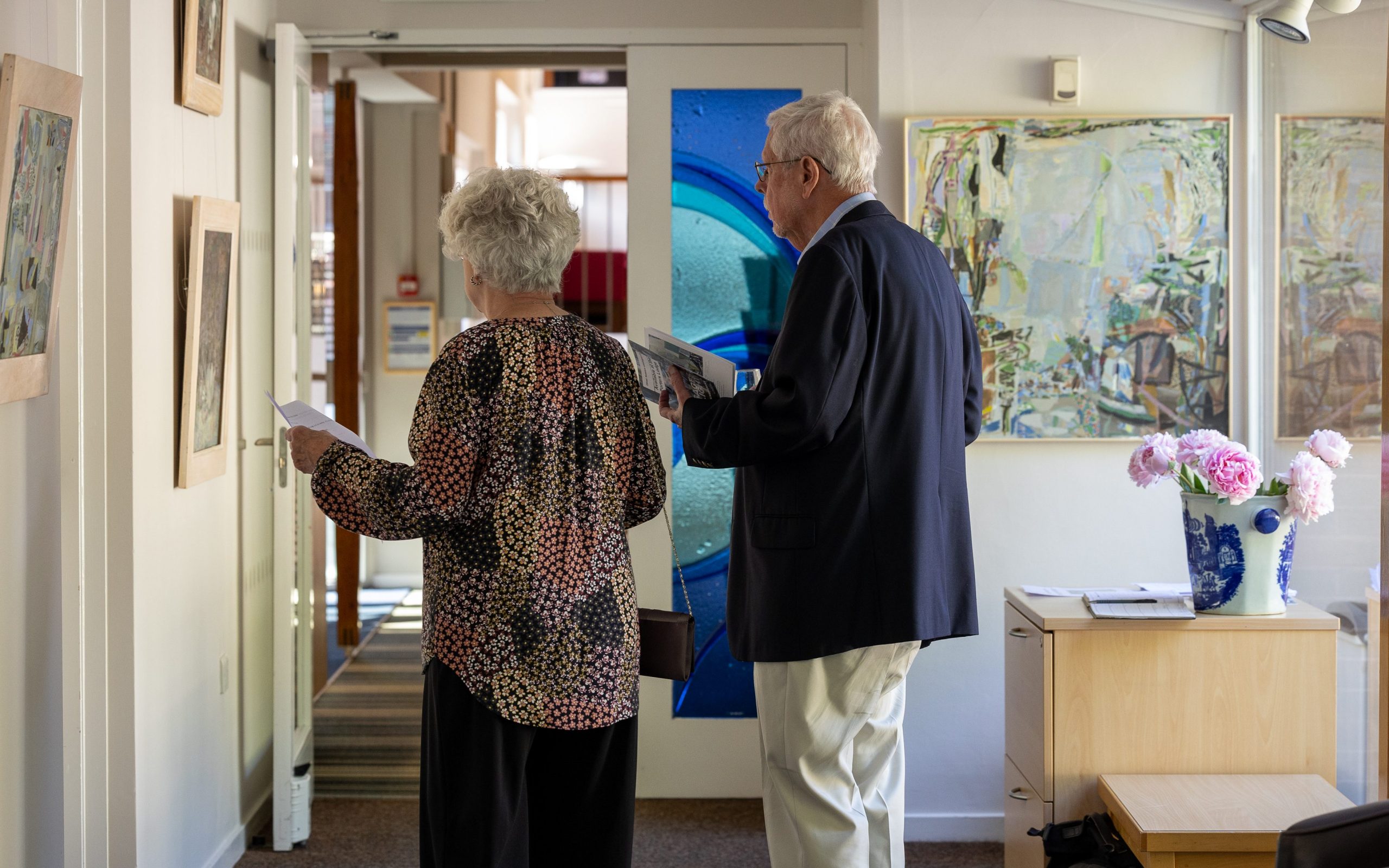Meet the Artist: Oliver Soskice

On the 8th of June 2023, Clare Hall previewed an exhibition by Cambridge artist Oliver Soskice, titled ‘Passages of Light.’ It was a warm and welcoming event enhanced by the late afternoon sun, criss-crossing from the side windows of the Common Room. Among the audience on that occasion was Martin Gayford, a well-known art critic and a leading authority on Lucian Freud and David Hockney. Equally welcome were the many comments that filled up the Visitor’s Book during the run of the exhibition. Among them was an admiring comment from artist Mark Cazalet, a former exhibitor at Clare Hall.
The exhibition ran until the 20th of July and was largely successful. Several pieces were sold, and the exhibition was greatly enjoyed by members of Clare Hall, as well as many visitors from outside of College. To learn more about Soskice and his paintings, we sat down with him for a conversation about his way of working and sources of inspiration.

Soskice was exposed to the world of painting from a young age. His great-great-grandfather was Ford Madox Brown, a key figure in the Pre-Raphaelite movement, who painted the notable piece titled Work. Additionally, Soskice’s next door neighbor was painter and critic Adrian Stokes, who was well known for his theoretical writings and still life paintings.
After reading English Literature at Trinity Hall, Cambridge, Soskice worked in publishing for two years in Dublin and Edinburgh before turning to painting full-time. He has lived and worked in Cambridge since 1988.
When Soskice began painting, he worked on more abstract pieces before switching over to focus on still lifes, due in part to the influence of Adrian Stokes’ work.
Soskice describes some of his artistic ideas through his interest in philosophy, such as the notion that there is an ‘inherent luminosity within the act of existing.’ This points to the native beauty of material things, and to be observant of the spatial depth of objects all around us.
Further, the idea of ‘inherent luminosity’ should underlie the notion of painting and still lifes in particular. As a simple exercise in philosophical realism, he suggests looking at a three-dimensional object, say a pear, and trying to envisage what the ‘unseen side’ looks like, further acknowledging the reality and virtue of objects outside of ourselves, and also the ordinary places we live in.

Photo Courtesy of Oliver Soskice
Take for instance Burrell’s Walk near Clare Hall, which you probably go through every day: the passageway that goes beside the University Library down to Queen’s Road. I’m very fond of that passage. The fall of light down through the foliage, particularly in summer when the sun is high, makes a kind of leopard skin of shadows on the ground. And then you see people coming along on their bicycles, and they’ve got one movement with their feet going up and down, but also they’ve got spotted shadows running up and over them. These things are as ordinary as water, but they’re what the visible world is made of. That’s what I mean by saying there are little epiphanies of great beauty that are happening all the time, everywhere.
– Oliver Soskice

When painting still lifes, Soskice describes thinking about ‘the depth of transparent air that envelops objects.’ The objects that he has chosen to work with range from cups and glasses to shells and fruits, some of them holding unique stories.
For example, growing up next door to the Stokes household has influenced his work, not only in style and form, but also in subject matter. In Brown still life with vase, wineglass and cup, the cup was made by Adrian Stokes’ wife, Ann Stokes, herself a distinguished potter.
In addition to the influence of philosophy, the works of Merleau-Ponty in particular, Soskice draws inspiration from playing the piano, and particularly the works of Bach. Somewhat analogous to musical counterpoint, some of his paintings can be thought of in terms of a leading voice and different harmonies that weave in and out. ‘I was saying to a friend I think there is sometimes something musical in my painting. And she said what do you mean? They are music.”

Displayed prominently throughout the Common Room were several of his larger abstract pieces. On a sunny day, streams of light would filter through the windows and illuminate these paintings, interacting with the various dancing strokes of colour. These works developed from the landscapes around Cambridge with their long horizon lines, ‘gradually absorbed into a stronger connection between the forms of earth and the clouds.’ Observing the alterations of distance between hedges, fences, trees and other elements reveal subtle passages of light.
‘I always think there’s a lovely kind of pale grey, green, silvery kind of light playing about some of the Cambridge landscapes,’ Soskice said. The colour tones can correspond to a different musical voice–soprano, alto, tenor, and baritone–as they become intertwined with one another. He attributes his inclination toward certain colours as having to do with different passages between the three primaries: red, yellow, and blue. While traversing between red and yellow provides only a few shades of orange, the long journey from blue to yellow opens up an ‘almost limitless fan of colours for me…the kind of colours I feel more at home with,’ Soskice said.


Photos by Jeremy Peters
These works have reminded us of the richness of everyday life, and encouraged us to appreciate the beauty that exists all around. We thank Oliver Soskice for his exhibition with Clare Hall, and the great joy his paintings have brought to members and visitors of the College.
Our next exhibition will begin on the 28th of September, and we look forward to providing more details soon.